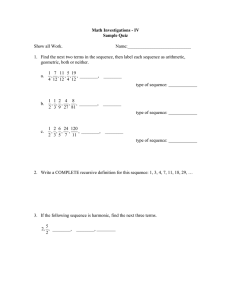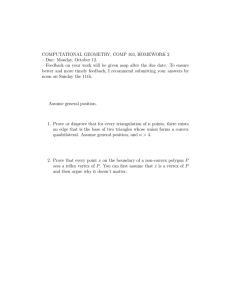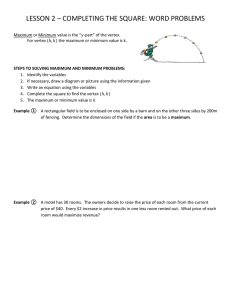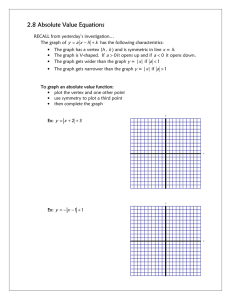6 December 2010
advertisement
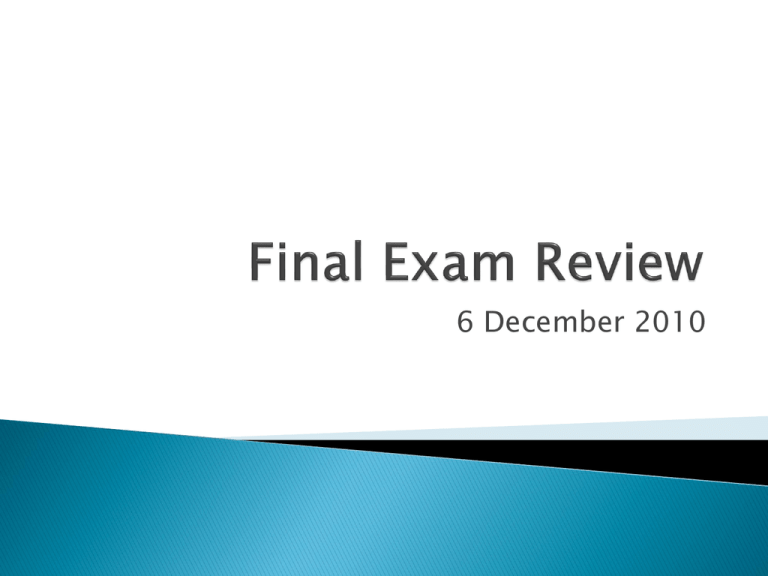
6 December 2010 Will be due tonight @ 11:59 p.m. Take a look at my “Review Notes” if you still have no idea how to approach the problem Stars in cells with no dependencies Runtime issue ◦ We will not impose runtime constraints, but you have to use backtracking ◦ Be aware that we will do less bug-fixing On Monday, 13 December @ 4:00 p.m. – 6:50 p.m. (NOT 4:30 p.m.) You are allowed 3 sheets of letter-sized paper with notes Review Sessions: 1. Tuesday, 7 December @ 1:00 p.m. – 3:00 p.m. in HEC 101 with Remo 2. Wednesday, 8 December @ 1:00 p.m. – 3:00 p.m. in HEC 101 with Chris Network Flow Proposed Solution: Books b1 w2 wn w1 x1 w1 w1 s Boxes b2 . . . bn c1 x2 w1 . . . xk c2 ck t Counter Example: x1 10 s 10 b1 8 10 x2 6 t ◦ Maximum Flow will be 10 ◦ BUT: book is “split up” between boxes x1 and x2 Edit Distance Remember: Y b a repl X c del ins n b n min(a 1, c 1, b 1) , if X Y , otherwise Backtracking ◦ You are given a set of letters, in random order, e.g. “OFCEFI” ◦ You have to determine whether or not there exists a way to reorder those letters to form a valid word. ◦ Given: A function “startswith(a)”, that determines if there are any words that start with the string “a” Backtracking function jumbledLetters(a, b) takes in a set of letters, a, already ordered, and set of letters, b, that needs to be added Base Cases: ◦ If startswith(a) == FALSE, return FALSE ◦ If b is empty string, return startswith(a) Recursively call jumbledLetters() with next set of letters If any of recursive calls return TRUE, return TRUE If all return FALSE, return FALSE Example: ◦ Call to jumbledLetters(“OF”, “CEFI”) (“OF”, “CEFI”) (“OFC”, “EFI”) (“OFE”, “CFI”) FALSE FALSE (“OFF”, “CEI”) (“OFFC”, “EI”) (“OFFE”, “CI”) . . . (“OFI”, “CEF”) (“OFFI”, “CI”) FALSE Single Room Scheduling (Lecture 11) Greedy Solution: 1) Sort the requests by finish time. 2) Go through the requests in order of finish time, scheduling them in the room if the room is unoccupied at its start time. Show Time Show Time Cops 6:30 – 7:30 Cops 6:30 – 7:30 CSI 7:30 - 8:30 CSI 7:30 - 8:30 30 Rock 7:00 - 9:00 Survivor 8:45 - 9:45 Office 8:00 - 9:00 Law & Order 9:50 - 10:50 Idol 6:00 - 9:15 Law & Order 9:50 - 10:50 Survivor 8:45 - 9:45 24 7:30 - 10:30 Law & Order 9:50 - 10:50 SportsCenter 9:15 - 11:00 MakeHeap (Lecture 4) 1) Place all the unsorted elements in a complete binary tree. 2) Going through the nodes in backwards order, and skipping the leaf nodes, run Percolate Down on each of these nodes. If one of the children is less than the node, swap the lowest. Continue until node has only larger (or equal) children or until leaf node Initial Heap: 19 17 3 22 4 87 1 26 14 13 67 35 12 6 Final Heap: 1 4 3 17 19 13 22 26 12 87 67 6 14 35 S 2i 1 2i n i 1 Solution: S 3 21 5 22 7 23 2S 3 2 2 5 23 S 3 21 2 22 2 23 2(20 21 22 (2n 3) 2 n 1 (2n 1) 2 n (2 n 1) 2 n 1 2 2 n 1 2n ) (2n 1) 2 n 1 2(2n 1 1) (2n 1) 2n 1 S (2n 1) 2n 1 2(2 n 1 1) (2n 1) 2n 1 2 (2n 1) 2 n 1 (2n 1) 2 n 2 2n (2 n 1) 2 n 1 Usually a good idea to break down initial equation as much as possible before proceeding S 2i 1 2i n i 1 2i 2 2i n n i i 1 2 i 1 n i2 i i 1 use S-Trick with x 2 n 2 i i 1 finite geometric sum Code Analysis a) What problem does this code solve? Matrix Chain Multiplication b) Symbolically, what does the variable “m” represent? At which matrix you want to split your multiplication a the top level. c) Explain conceptually what is stored in the variables “one”, “two”, and “three”. • “one” stores number of multiplications to do the left-side product • “two” stores number of multiplications to do the right-side product • “three” stores number of multiplications to take the two products from two recursive calls and multiply them d) Is the method “function” efficient? Justify. No. The exact same recursive call gets made multiple times. Index 0 1 2 3 4 5 6 7 8 9 Value 2 3 6 3 8 1 7 3 5 7 Index 0 1 2 3 4 5 6 7 8 9 Value 2 3 6 3 8 1 7 3 5 7 a) b) Which row (0 – 9) is this in the path array? 3 Determine the vertices traversed in the shortest path from vertex 3 to vertex 0. 37620 c) From the information given, can we determine which vertex is farthest away from vertex 3? Why or why not? No. Because of insufficient weight info. 3 10 2 -5 0 CHEESE!


